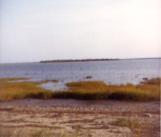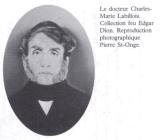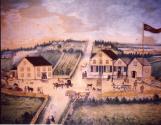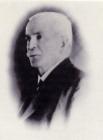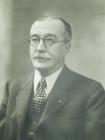2
Alexander Key, doctorDoctor Key was Scottish. He arrived in New Brunswick in 1816. He was the doctor hygienist assigned to the quarantine service for the port of Chatham, as well as a practicing surgeon. Having been named as doctor at the lazaretto on Sheldrake Island, he was asked to write up a code containing the notices, the appropriate rules for the administration of the lazaretto and the dietary regimes for the sick. It seems that he did none of this. He was convinced that the disease was contagious, but recognized however, that certain people were more susceptible than others to become infected. He hoped that he would be able to cure a few patients by regularly changing bandages treated with "bichoride of mercury" and iodine. The patients took this faint expressed hope as a promise. They became disillusioned when it became obvious that these treatments brought no cure. Some continued to apply ointments, but refused to take the oral medicines. Disarray and bitterness quickly settled in Sheldrake and the lepers lost all trust in Dr. Key.
He was a member of the first Bureau of Health for the counties of Northumberland and Gloucester.
4
Charles Marie Labillois, 1793-1868. The forgotten doctorCharles Marie Labillois was born in Ploërmel in the Morbihan in Brittany, July 8th, 1793. He settled in Saint Joseph de Carleton, Quebec for unknown reasons in 1816. He married Amélie Meagher on October 4th of the same year. They had eleven children together.
Labillois was the resident doctor at the lazaretto in Tracadie from September to December in 1849. He returned from July until the end of December in 1850. He was never paid for his services. The treatments he administered to the lepers during his stay at the lazaretto were nevertheless effective. As stated by the secretary of the Bureau of Health: "All the lepers concur that their health is better and seem quite happy".
No other doctor had given of himself as much as Dr. labillois to care for the lepers since the opening of the first lazaretto on Sheldrake Island. No doctor had deserved as much respect and affection from the sick and their families. He treated the lepers risking his own life and health. He received from the French government the medal of Sainte Hélène created by the emperor Napoléon 111 in 1857.
Dr. Labillois died at the age of 76 on September 16th, 1868. He is buried in Saint Joseph de Carlton's parish cemetery in Québec.
6
Robert Gordon, doctor, 1799-1863Doctor Robert Gordon was born of Scottish parents in 1799. He practiced medicine in Bathurst. He was named a member of the County's medical commission to investigate the "disease" that was rampant in the region of Tracadie. He was also responsible for visiting Tracadie's lazaretto which he did a few times a year from 1851 to 1863.
He became a member of the Legislative Assembly of New Brunswick in 1850.
He died in Fredericton in 1863 and is buried in Bathurst.
The lazaretto at the time of doctor Gordon's visits. This painting shows the lazaretto surrounded by a fence.
7
Doctor Nicholson James, first specialist doctor in the lazaretto1863
Tracadie, New Brunswick, Canada

8
James Nicholson, doctor, 1834-1865Doctor Nicholson settled in Bathurst in 1856 after having studied at New York University. He arrived in Tracadie as a specialist on May 3rd, 1863. He would be the first resident physician. He believed leprosy to be hereditary and not contagious. He went so far as to inoculate himself with the disease to prove his theory. Dr. Nicholson's presence brought some relief and order among the lepers. He organized outdoor games and exercises to reduce boredom. He subsequently made arrangements to procure a boat for them for fishing and navigating.
He died of phtisis at 31 years of age on April 11th, 1865.He is buried in Chatham's St Andrew Church cemetery.
Dom Felix Lajat said of Dr. Nicholson that:"He left a reputation as a devoted man much appreciated by the lepers".
9
Doctor Alfred Corbett Smith, first resident doctor at Tracadie1865
Tracadie, New Brunswick, Canada

10
Alfred Corbett Smith, doctor, 1841-1909Son of James Smith and Suzanne M. Dunn of Bathurst, Albert Corbett was born June 7th, 1841. He married Helen Young, daughter of James Young and Ann Ferguson of Tracadie, May 2nd, 1866. He practiced medicine in Newcastle before being named in charge of the lazaretto in 1965. He had a general practice in Tracadie, an area where he would be the only doctor in a 50 miles radius.
There always was a certain distance between Dr. Smith and the French population in which he worked. Firstly, he was not Catholic and secondly, he was English. It seems that despite this, Tracadie's population remembers him warmly as a very nice man. He was known to diagnose poor people and treat them free of charge. He even paid out of pocket, on occasion, for certain medications. He recognized, like doctors of his time, that leprosy was incurable. He was not interested at that moment in finding a remedy. He seeked rather to alleviate its symptoms. His work was greatly appreciated. He made life easier for his patients. He removed all the bars from the windows. He stayed on until his death in 1909.
Dr. Smith was identified with the hospitallers of Tracadie's work until his death on March 12th, 1909 at 68 years of age. He is buried in the Protestants' cemetery in Tracadie Sheila, New Brunswick.
12
Joseph Antoine Langis, doctor, 1851-1939Doctor Joseph Antoine Langis of Rimouski, Quebec, graduate of the Université de Montreal, practiced many years in Petit Rocher, New Brunswick before continuing the work of Dr. A. C. Smith at Tracadie's lazaretto from 1909 to 1933. Dr. Langis' responsabilities were lesser and his powers were limited, but his working conditions had greatly improved since the beginning of the lazaretto. He was the first doctor to write up the case history of each patient and to attempt to retrace the disease back to their individual families. Apart from his work at the lazaretto, he also had a private practice in Tracadie. This was the case for the other doctors that also assumed the role of superintendent after him.
Doctor Langis was superintendent for 23 years. During which, the number of cases of leprosy decreased considerably, from 23 on the year of his arrival(1909) to 10 at that time of his retirement in 1933.
14
Walter Thomas Ryan, doctorDoctor Walter Thomas Ryan of Fredericton, New Brunswick studied at McGill University from which he graduated in 1901.
He was a general practitioner in Boiestown, but since he had to spend many a night on the road due to New Brunswick's vast rural expanses, he quickly opted for a less demanding medical practice. Thus, he began his service at the lazaretto in 1933. He was immediately given the job of superintendent to replace Dr. Langis who had just retired. Dr. Ryan died of heart disease on February 19th, 1939.
